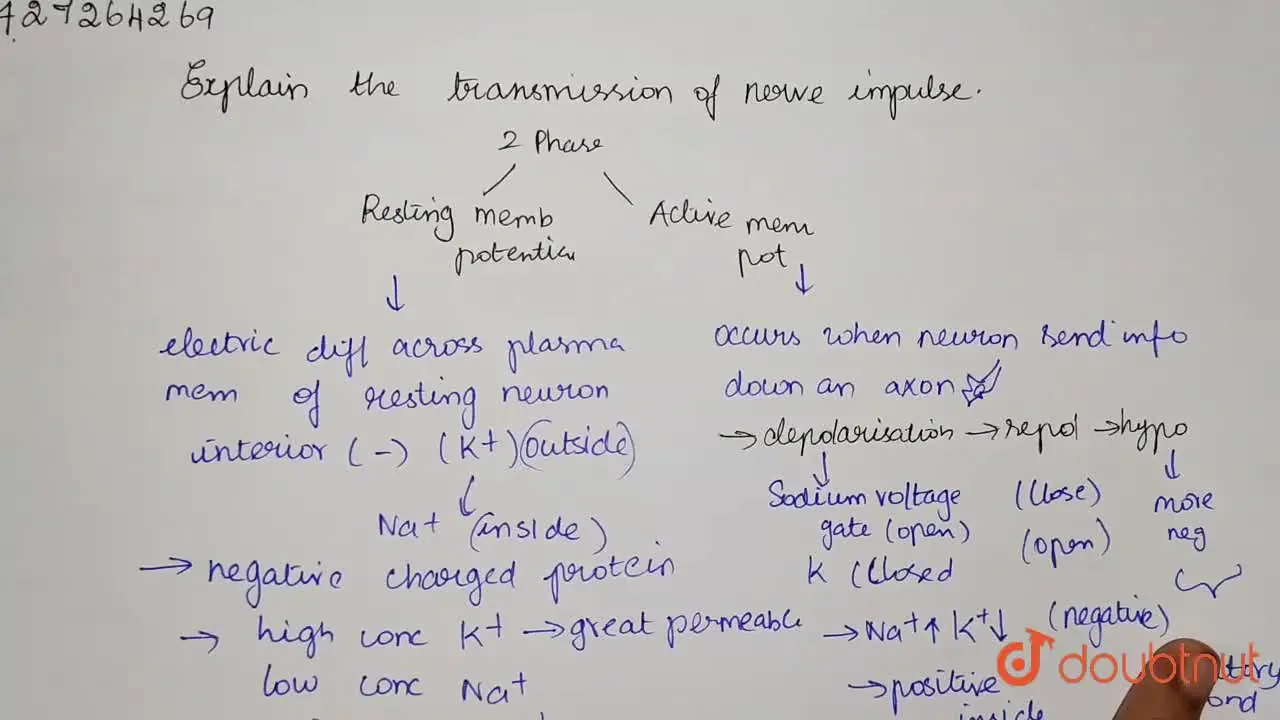Explain the transmission of nerve impulses.Solution in Tamil
The transmission of impulse involves two main phases, Resting membrane potential and Action membrane potential. Resting membrane Potential: The electrical potential difference across the plasma membrane of a resting neuron is called the resting potential during which the interior of the cell is negative due to greater efflux of K+ outside the cell than Na+ influx into the cell. When the axon is not conducting any impulses i.e. in resting condition, the axon membrane is more permeable to K+ and less permeable to Na+ ions, whereas it remains impermeable to negatively charged protein ions. The axoplasm contains high concentration of K+ and negatively charged proteins and low concentration of Na+ ions. In contrast, fluid outside the axon (ECF) contains low concentration of K+ and high concentration of Na+, and this forms a concentration gradient. This ionic gradient, across the resting membrane is maintained by ATP driven Sodium-Potassium pump, which exchanges 3Na+ outwards for 2K+ into the cells. In this state, the cell membrane is said to be polarized. In neuron, the resting membrane potential ranges from -40 mV to –90 mV, and its normal value is -70 mV. The minus sign indicates that the inside of the cell is negative with respect to the outside.
Action membrane potential: An action potential occurs when a neuron sends information down an axon, away from the cell body. It includes following phases, depolarization, repolarisation and hypopolarization.
Depolarization - Reversal of polarity: When a nerve fibre is stimulated, sodium voltage-gate opens and makes the axolemma permeable to Nations, meanwhile the potassium voltage-gate closes. As a result, the rate of flow of Nations into the axoplasm exceeds the rate of flow of K+ ions to the outside fluid [ECF]. Therefore, the axolemma becomes positively charged inside and negatively charged outside. This reversal of electrical charge is called Depolarization. During depolarization, when enough Na+ ions enter the cell, the action potential reaches a certain level, called threshold potential [-55 mV]. The particular stimulus which is able to bring the membrane potential to threshold is called threshold stimulus. The action potential occurs in response to a threshold stimulus but does not occur at subthreshold stimuli. This is called all or none principle. Due to the rapid influx of Nations, the membrane potential shoots rapidly up to +45 mV which is called the Spike potential. Repolarisation [Falling Phasel: When the membrane reaches the spike potential, the sodium voltage-gate closes and potassium voltage-gate opens. It checks influx of Na+ ions and initiates the efflux of K+ ions which lowers the number of positive ions within the cell. Thus potential falls back towards the resting potential. The reversal of membrane potential inside the axolemma to negative occurs due to the efflux of K+ ions. This is called Repolarisation
Hyperpolarization: If repolarization becomes more negative than the resting potential -70 mV to about -90 mV, it is called Hyperpolarization. During this, K+ ion gates are more permeable to K+ even after reaching the threshold level as it closes slowly, hence called Lazy gates. The membrane potential returns to its original resting state when K+ ion channels close completely. During hyperpolarization the Nat voltage gate remains closed.
Conduction Speed of a nerve impulse: The conduction speed of a nerve impulse depends on the diameter of axon. The greater the axon's diameter, the faster is the conduction. The myelinated axon conducts the impulse faster than the non-myelinated axon. The voltage-gated Na+ and K+ channels are concentrated at the nodes of Ranvier. As a result, the impulse jumps node to node, rather than travelling the entire length of the nerve fibre. This mechanism of conduction is called Saltatory Conduction. Nerve impulses travel at the speed of 1–300 m/s.
Related Playlists
- BOOK - FULL MARKSCHAPTER - NEURAL CONTROL AND COORDINATIONEXERCISE - ADDITIONAL QUESTIONS SOLVED (Short Answer Questions)40videos
NEURAL CONTROL AND COORDINATION
- BOOK - FULL MARKSCHAPTER - MINERAL NUTRITIONEXERCISE - ADDITIONAL QUESTIONS SOLVED - MULTIPLE CHOICE QUESTIONS5videos
MINERAL NUTRITION
- BOOK - FULL MARKSCHAPTER - ORGAN AND ORGAN SYSTEMS IN ANIMALS EXERCISE - ADDITIONAL QUESTIONS SOLVED (III Answer the following Questions)35videos
ORGAN AND ORGAN SYSTEMS IN ANIMALS
Similar Questions
What are neurons? What are their functions.
04:04View SolutionCarnivorous plants like Nepenthes and Venus fly trap have nutritional adaptation. Which nutrients do they especially obtain and from where?
01:39View SolutionClassify earthworms based on their ecological strategies.
05:24View SolutionTransmission of nerve impulse is unidirectional due to
02:22View SolutionTransmission of nerve impulse at synapses is a
01:34View SolutionExplain the transmission of nerve impulse along a nerve fibre.
02:47View SolutionExplain the following processes :
Transmission of a nerve impulse across a chemical synapse.02:14View SolutionTransmission of light into nerve impulse is a :
05:07View Solutionनिम्न में भेद स्पष्ट कीजिए-
आच्छादित एवं अनाच्छादित तंत्रिका तन्तु में आवेग संचरण02:18View SolutionExplain the following process : Transmission of a nerve impulse across a chemical synapse.
36:47View SolutionExplain the following processes: Transmission of a nerve impulse across a chemical synapse
36:58View SolutionDiscuss mechanism of transmission of nerve impulse.
30:48View SolutionTransmission Of Nerve Impulse
02:04View SolutionNerve Impulse|Generation#!#Conduction#!#Transmission
View SolutionNerve Impulse|Generation#!#Conduction#!#Transmission
View Solution


